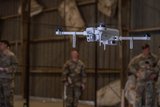Lethality of DF-21D anti-ship missile revealed
Designed specifically to destroy US aircraft carriers, the DF-21D anti-ship ballistic missile (ASBM) is one of China’s key anti-access area denial weapons. However, how it would work exactly has been a matter of debate since it reached initial operating capacity in 2010.
China is the first country to develop an ASBM after it modified the standard road-mobile DF-21 medium-range ballistic missile.
Now China’s military appears more than capable of penetrating an aircraft carrier’s battlespace with a combination of air-, submarine- and surface ship-launched anti-ship YJ-series cruise missiles, not to forget the varieties of torpedoes available to its submarine force. Of particular
Already have an account? Log in
Want to keep reading this article?
More from Defence Notes
-
![What will next-gen counter-UAS capabilities for the US look like?]()
What will next-gen counter-UAS capabilities for the US look like?
Future US counter-uncrewed aerial system solutions are likely to require a flexible, multi-layered approach to tackle a broad spectrum of new threats as they emerge.
-
![Elbit Systems awarded $2.3 billion contract as results soar]()
Elbit Systems awarded $2.3 billion contract as results soar
The company’s order backlog as of 30 September totalled $25.2 billion and more than a third of this is scheduled to be fulfilled before the end of 2026.
-
![US military foresees growing use of 3D printing]()
US military foresees growing use of 3D printing
Advanced manufacturing has evolved to meet military requirements and now supports multiple US critical assets, including Arleigh Burke-class destroyers, F-18, F-22, F-35, Bradley, HMMWV and Patriot.
-
![Irish Naval Service expands as the country looks to defence during EU presidency]()
Irish Naval Service expands as the country looks to defence during EU presidency
The Irish Naval Service has struggled to maintain capability, particularly in the face of lucrative private sector offers luring away personnel.
-
![Resilience, adaptiveness and collaboration vital for success in space (Studio)]()
Resilience, adaptiveness and collaboration vital for success in space (Studio)
Speakers at the Defence In Space Conference (DISC) 2025 highlighted the critical and evolving role of space in national security, defence and the global economy.

























